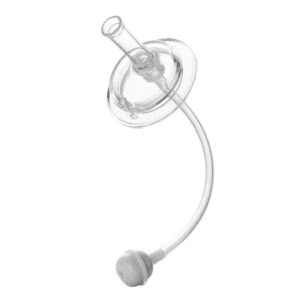Gomma siliconica liquida (LSR) lo stampaggio a iniezione è un metodo per renderlo elastico, componenti durature in grandi quantità. Ulteriori informazioni sulle caratteristiche chiave, benefici, e usi dello stampaggio a iniezione di gomma in silicone liquido leggendo questo articolo.
Cos'è la gomma silicone liquida (LSR) Stampaggio a iniezione?
La tecnica di produzione più popolare, stampaggio a iniezione liquida, viene utilizzato in gomma silicone liquida (LSR) modellare per creare un'ampia varietà di prodotti da componenti LSR grezzi. Con miscelazione di impingement pressato, Il processo di stampaggio a iniezione è diverso dalla norma. Le tecniche di miscelazione meccanica sono utilizzate nello stampaggio a iniezione liquida, che viene utilizzato principalmente per elastomeri come la gomma silicone liquida (LSR) e gomme liquide correlate.
Il primo metodo per creare componenti in gomma siliconica, gomma ad alta coerenza (HCR) stampaggio a iniezione, è ancora ampiamente usato oggi. Tuttavia, Per molti produttori di prodotti in gomma, Lo stampaggio a iniezione liquida è l'opzione migliore. A causa delle sue eccezionali prestazioni del prodotto, compresa la sua resistenza alla trazione, flessibilità, precisione, e longevità. La capacità di produrre continuamente e con alti livelli di automazione è un altro vantaggio dello stampaggio di iniezione liquida.
Processo di stampaggio a iniezione in gomma in silicone liquido
La parte successiva fornisce una procedura dettagliata dell'intero processo di stampaggio in gomma in silicone liquido:
-
- Il silicone liquido non curato viene immagazzinato in due secchi o tamburi di fornitura. La sostanza che forma base è mantenuta in uno di quei contenitori. L'alternativa ha un catalizzatore.
-
- È presente un dispositivo di misurazione. I due materiali dovrebbero essere rilasciati automaticamente in una proporzione sia uguale che costante. I dispositivi di misurazione rilasciano anche eventuali additivi da colorare che possono essere presenti.
-
- L'operatore può personalizzare e configurare la macchina da stampaggio in gomma in silicone per renderlo automatizzato. Per garantire una dimensione di tiro uniforme per ogni articolo, L'iniezione è su misura.
-
- Prima di sigillare lo stampo, le piastrine e i pistoni sono allineati. A seconda dei parametri, L'allineamento ha più impostazioni per la pressione applicata, temperatura, durata del ciclo, e tasso di iniezione.
-
- La macchina per lo stampaggio si riscalda e la temperatura dello stampo aumenta dopo che l'operatore imposta tutte le variabili. Il morsetto sullo stampo è soggetto alla giusta quantità di forza di serraggio.
-
- La gomma siliconica è forzata nella cavità dello stampo con l'aiuto di un meccanismo di iniezione dopo la chiusura dello stampo e la pompa e l'iniettore sono pronti.
-
- Alla corretta pressione e temperatura, Le gomme da silicone liquido sono curate fino a quando non si verifica la solidificazione.
-
- L'utente può rimuovere fisicamente il prodotto in gomma siliconica una volta consolidato. È anche possibile utilizzare un meccanismo di eiezione automatizzato con Gippers. Tuttavia, Poiché la gomma silicone è così flessibile, I pin di espulsione non sono necessari per la rimozione.
Prendi anche nota delle procedure di post-medizzazione, inclusa la pulizia, ispezione, e imballaggio. Queste procedure sono ugualmente importanti per garantire la qualità delle merci in gomma silicone.
Macchina per stampaggio a iniezione liquida
In un kit, Il materiale in gomma in silicone liquido si presenta in genere in due parti, A e b. I seguenti sono gli elementi essenziali del processo di stampaggio di iniezione LSR in due parti:
- Drum di fornitura: Il sistema di pompaggio è collegato a queste brocche o stanchi liquidi in silicone. Un terzo contenitore di pigmenti è in genere incluso nelle configurazioni a due contenuti.
- Unità di misurazione: Per mantenere un rilascio contemporaneo costante, Questo dispositivo di misurazione pompa due materiali in silicone liquido (A e b) a rapporti specificati.
- Mixer: I componenti in silicone liquido dall'unità di misurazione sono combinati in questo miscelatore statico prima di essere pressioni e iniettati nello stampo.
- Iniettori: Usando la forza pressata, Questo dispositivo sposta il materiale di formazione LSR nel meccanismo di pompaggio.
- Ugelli: Gli ugelli consentono ai prodotti chimici di formazione del liquido di entrare nello stampo.
Design di stampaggio LSR
Stampaggio ad iniezione di liquidi (LIM) può essere utilizzato per produrre gomma a silicone liquido (LSR). Un sistema a colonne a freddo utilizza un file 1:1 miscela di materia prima liquida dai due componenti distinti per iniettarla in uno stampo riscaldato. Il vantaggio del ciclo rapido e della produzione rapida è fornito dal breve periodo necessario per curare.
Ciò che è il materiale utilizzato per preparare la gomma siliconica?
Polisilossano, a volte indicato come gomma siliconica nella scienza, è un elastomero costituito da silicio, carbonio, idrogeno, e ossigeno. È sicuro da usare per le tettarelle dei biberon e abbastanza resistente da resistere ai rigori dei motori a reazione. Il polimero ad alte prestazioni a base di silicio metallico e polvere di silice è noto come gomma siliconica.
Prodotti di stampaggio LSR


Conclusione
Creiamo di alta qualità, LSR progettato su misura, LSR eccessivo, E LSR 2-Shot componenti a LGDSilicone. Oltre ad essere utilizzato nelle applicazioni di consumo e medica, I nostri prodotti sono apprezzati nelle aree automobilistiche e industriali.